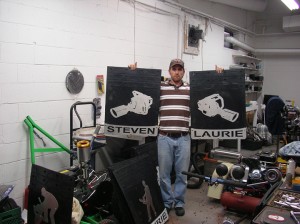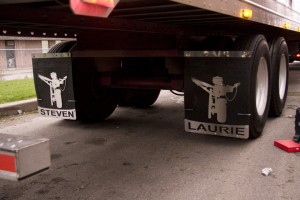Industrial Revelation
When Walter Benjamin said “[…] the work of art reproduced becomes the work of art designed for reproducibility”, he was referring to the idea that the mechanical reproduction of artworks was changing some aspects of how art was produced and perceived. Notions of authenticity and the “originality” of an art object were drifting. Since Benjamin’s 1935 statement, the situation has changed somewhat. In a post-industrial society it seems that the object designed for reproducibility has, to an ever-greater degree, become the work of art. With industrialization and mass production a well-established part of our shared cultural heritage, artists plumb the depths of its various manifestations and discover echoes of ourselves. Steven Laurie’s mud flap project, which continues his exploration of automotive customization and the relationships we have with our machines, takes a close look at the connections between art, industry, and advertising.
Consisting of pre-fabricated rubber mud flaps embellished with fine, water-cut chrome silhouettes — of either one of Laurie’s sculptural machines or of him operating one of the machines — and installed on working transport trucks and tractor-trailers, Laurie’s mobile yet site-specific sculptural installations cross the boundaries between art, utility, and advertising. They come in pairs, each with the same image, one labeled “Steven” and the other “Laurie”. The text is readable as both the artist’s signature and as a brand name. These works are part of Laurie’s ongoing quest to erect bridges between the worlds of art and the seemingly artless realm of the so-called “working class”. Utilizing the forms and iconography of his own working class background, including references to both labour and leisure, he identifies sensitive spaces within this territory and places himself squarely inside them. He transforms a moving truck on Highway 403 into a place where art can happen in a manner similar to graffiti but sanctioned by the aura of advertising. While keeping a foot firmly planted in the context of his artistic practice, the status of these objects becomes less clear when installed, where they become an active part of the industrial complex, fluctuating between states of utility and aesthetics. However, instead of attempting to transform art into something superficially industrial and utilitarian, Laurie is aestheticizing and re-contextualizing industrial tools and material. In addition, the format and presentation of these works positions them more as products, and positions Laurie more as a brand. In doing so he asks a torrent of questions about cultural commodification and co-option but also about the difference, if there is one, between an artwork and a consumer product. In their indeterminacy, the works seem to slip back and forth between these functions. They constitute a clear, tangible link between the world of Laurie’s practice and the social and cultural structures he delves into with his work, while at the same time posing questions about the boundaries between advertising and art, and the legitimacy of pre-fab customization.
Customization, which can be seen as the marriage of utility and aesthetics, lies at the core of Laurie’s practice. Automotive maintenance and customization represent a collection of rituals that hover between the labour and leisure activities of the working class life. It is within the physical and psychological arena of this phenomenon that Laurie plants himself. Examining his own connection to this lifestyle, Laurie explores the actions connecting these activities as unique expressions of culture and advances this argument by presenting his customized objects as a brand name like so many other after-market accessories. The honesty and lack of irony in his work is illustrated in his interest in exposing it to those who are fully capable of critiquing it’s construction. Like his series of sculptural machines, these works turn the tables on the art world insofar as the curator or gallery patron may not, quite jarringly, be the person best equipped to analyze and critique them. In fact, since the works are not intended to be exhibited in a traditional gallery space, their various installation sites and the nature of their travel encourage a dialogue, concentrated between the driver and his peers who may discuss them while resting at truck stops. Laurie undoubtedly gleans some satisfaction from inspiring truckers to talk about art amongst themselves.
Laurie’s desire to connect with an audience outside the realm of galleries and artist-talks is sincere, though perhaps not entirely a utopian effort. By branding himself and disseminating his artwork on functional transport trucks, he effectively makes his art work within our capitalist system in a way that brings the role of art and the artist into question. Is there a defining line between a utilitarian object and a work of art? Many modernist works have explored this question but most often by bringing objects into the fold of the gallery. With his mud flap project, Laurie considers the reverse and examines how a work of art can migrate from the white cube of the gallery and make it’s own way in the world, making a very real contribution to our society while provoking some thought and a little dialogue along the way.
By Brad Isaacs, Artist and Curator http://brad-isaacs.com/


